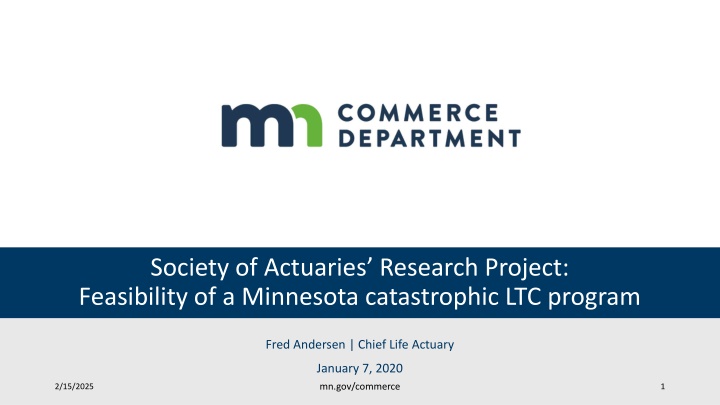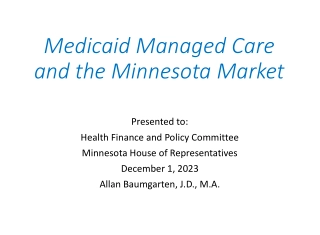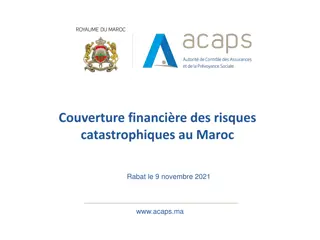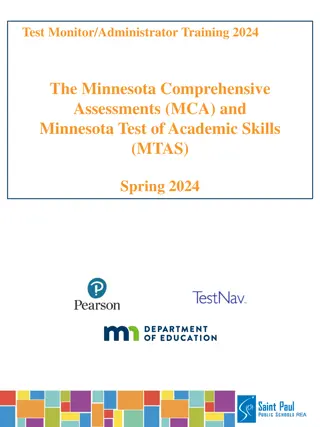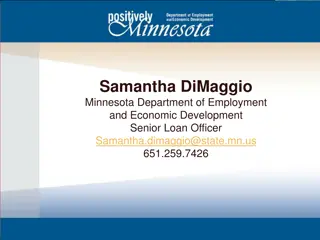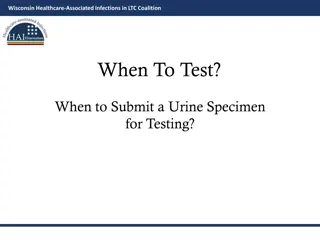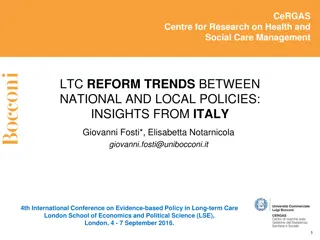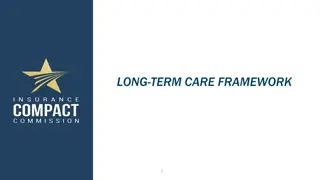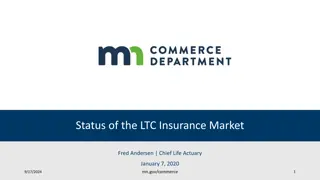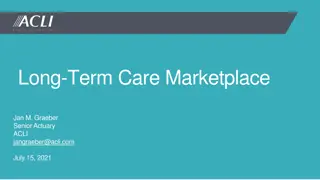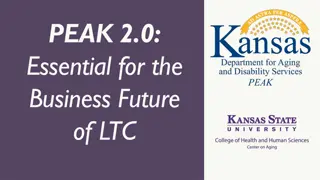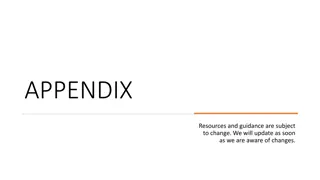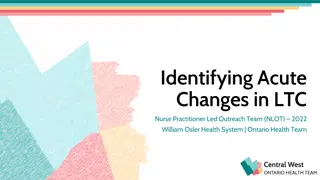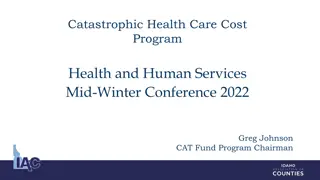Feasibility of Catastrophic LTC Program in Minnesota
This research project delves into the feasibility of implementing a catastrophic long-term care (LTC) program in Minnesota. It examines reasons for this focus, background on LTC funding, funding needs analysis, and various funding strategies. The study evaluates the potential impact on caregivers, the role of private insurance and Medicaid, and mathematical models for funding LTC needs under different scenarios.
Download Presentation

Please find below an Image/Link to download the presentation.
The content on the website is provided AS IS for your information and personal use only. It may not be sold, licensed, or shared on other websites without obtaining consent from the author.If you encounter any issues during the download, it is possible that the publisher has removed the file from their server.
You are allowed to download the files provided on this website for personal or commercial use, subject to the condition that they are used lawfully. All files are the property of their respective owners.
The content on the website is provided AS IS for your information and personal use only. It may not be sold, licensed, or shared on other websites without obtaining consent from the author.
E N D
Presentation Transcript
Society of Actuaries Research Project: Feasibility of a Minnesota catastrophic LTC program Fred Andersen | Chief Life Actuary January 7, 2020 mn.gov/commerce 2/15/2025 1
Outline Brief overview of the idea Reasons for this program to be the focus of the research project Details of a potential program 2
Reasons for this focus Background on LTC funding recent history / strategies Upcoming issues 3
Background Addressing / Funding for LTC needs Reliance on family caregivers Typically occurs in early LTC stages Can have negative impacts on caregivers Lost money, career opportunities, time with family, free time Oftentimes results in burn out Savings $50,000 to $100,000 targeted solely for LTC can be enough for many cases However, for lengthy cases, typically Alzheimer s / dementia, not nearly enough 2/15/2025 mn.gov/commerce 4
Funding for LTC needs Private insurance $200 per month in premiums can often fund most of an LTC event With rate increases resulting from costs being higher than expected: Tough to budget; Some products, especially newer ones, have limitations Medicaid Last resort, but very common source of LTC funding Kicks in after spend-down / poverty Concern is sustainability with baby boomers aging 2/15/2025 mn.gov/commerce 5
Analysis Funding LTC needs Each private funding strategy has pros and cons Analyzing 4 strategies / 4 scenarios / 4 winners Strategies: Standalone insurance (3-year or lifetime benefits), combo product, savings Begin funding at age 55 LTC need scenarios: Little or none, moderate, high-case, catastrophic 2/15/2025 mn.gov/commerce 6
Math Funding LTC needs Initial monthly outlay Little/No LTC Moderate LTC High-case LTC Catastrophic LTC Standalone Insurance (3-year benefit) $ 200 $ 200 $ 200 $ 1,200 Standalone Insurance (lifetime benefit) $ 300 $ 300 $ 300 $ 300 Combo / Accelerated Whole Life $ 450 $ 450 $ 450 $ 450 Savings for high-case LTC $ 600 $ 600 $ 600 $ 600 2/15/2025 mn.gov/commerce 7
Math Funding LTC needs Investment view Little/No LTC Moderate LTC High-case LTC Catastrophic LTC Standalone Insurance (3-year benefit) $60,000 spent no return $20,000 more in claims than premiums $100,000 more in claims than premiums Claims > premiums, then unmet need Standalone Insurance premiums (lifetime benefit) $90,000 spent no return $10,000 less in claims than premiums $70,000 more in claims than premiums $330,000 more in claims than premiums All money returned to beneficiary Some money for LTC, some for beneficiary Combo / Accelerated Whole Life Most money for LTC All money for LTC All money available to beneficiary Savings for high-case LTC Most money for LTC All money for LTC Unmet need 2/15/2025 mn.gov/commerce 8
Math Funding LTC needs Note that starting funding at age 40 instead of age 55 could reduce monthly outlay in half. 2/15/2025 mn.gov/commerce 9
Reasons for Catastrophic LTC program study All LTC funding strategies can be expensive Most people start thinking about LTC funding needs after age 55 Making funding even more expensive Even with most funding strategies, there can be unmet needs Particularly with lengthy, catastrophic cases Medicaid sustainability is becoming more and more of an issue As baby boomers convert from caregivers to care receivers 2/15/2025 mn.gov/commerce 10
Reasons for Catastrophic LTC program study If the biggest financial challenge is addressed through a public program: Consumers would have security and maintain incentive to finance more affordable, shorter-term needs Savings, planning, or private insurance Medicaid could focus on its intent Health coverage for lower-income and lower-wealth people Private insurers LTC products would supplement the catastrophic coverage Less risky for the insurers likely more affordable products developed 2/15/2025 mn.gov/commerce 11
Alternative LTC public programs pros and cons Front-end program Higher utilization Lower Medicaid impact? Difficult to coordinate with personal savings and private insurance? Alzheimer s/dementia-focused program Alzheimer s/dementia tends to be the costliest/lengthiest LTC type Would pick up LTC costs related to this diagnosis nearly at first dollar? This alternative will be studied as part of the project 2/15/2025 mn.gov/commerce 12
Potential structure Funding through payroll tax Forces funding to start at earlier age (than typical age 55), which substantially reduces monthly funding cost. Medicaid savings will result availability to fund this type of program will be studied Washington State has a different type of LTC program (front-ended) which is funded by a payroll tax. Benefit eligibility 2/15/2025 mn.gov/commerce 13
Thank You! Fred Andersen Frederick.andersen@state.mn.us 2/15/2025 mn.gov/commerce 14
